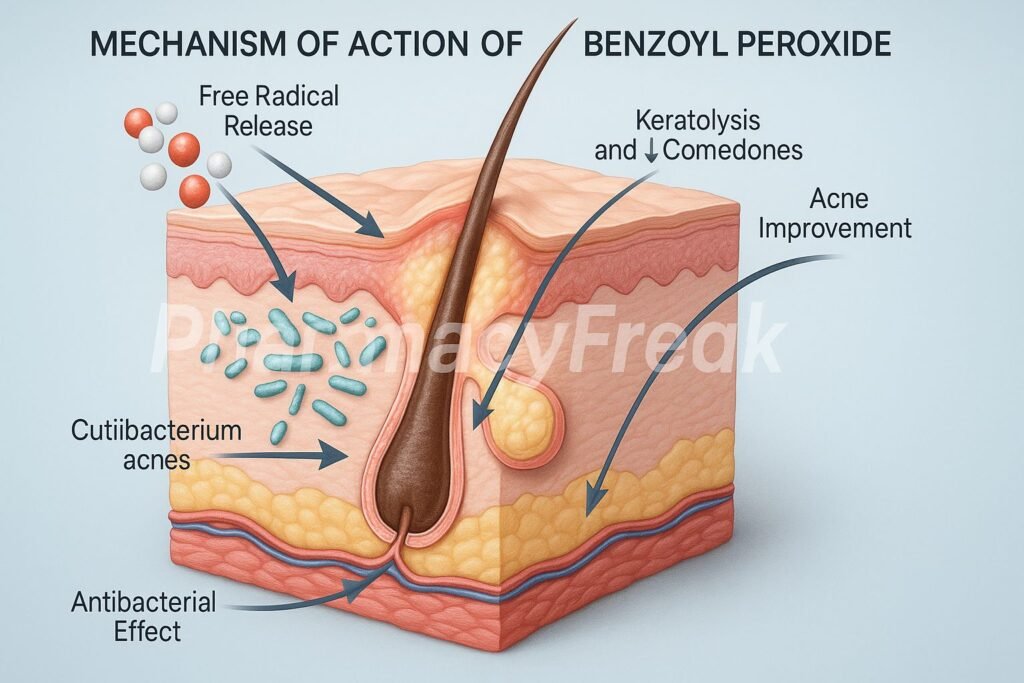Table of Contents
Introduction
Benzoyl peroxide is a topical antimicrobial and keratolytic agent widely used in the management of acne vulgaris. It is considered a first-line therapy for comedonal, inflammatory, and mild-to-moderate acne. Benzoyl peroxide is known for its powerful bactericidal activity, ability to reduce sebum, and its capacity to prevent antibiotic resistance when used with topical or oral antibiotics.
Its unique chemical structure allows it to release reactive oxygen species (ROS), which directly kill acne-causing bacteria and promote exfoliation and unclogging of pores.


Mechanism of Action (Step-wise)
1. Release of Reactive Oxygen Species (ROS)
- Benzoyl peroxide undergoes enzymatic breakdown on the skin surface.
- This breakdown releases free oxygen radicals, also known as reactive oxygen species (ROS).
- These ROS cause oxidative damage to Cutibacterium acnes (formerly Propionibacterium acnes).
Effect: Rapid bactericidal action without promoting bacterial resistance.
2. Antimicrobial Action Against C. acnes
- C. acnes thrives in anaerobic (oxygen-poor) environments inside hair follicles.
- The oxygen released from benzoyl peroxide destroys the anaerobic environment, killing the bacteria.
- Reduction of bacteria lowers inflammation, redness, and pustule formation.
3. Keratolytic and Comedolytic Effect
- Benzoyl peroxide helps in the desquamation of the stratum corneum.
- It reduces keratin plug formation inside follicles.
- This unclogs pores and prevents formation of:
- Closed comedones (whiteheads)
- Open comedones (blackheads)
4. Anti-inflammatory Action
- Decreases inflammatory mediators produced by C. acnes, such as:
- Lipases
- Porphyrins
- Free fatty acids
- Reduces swelling, erythema, and tenderness in inflammatory acne lesions.
5. Regulation of Excess Sebum
- Mild sebum-reducing effect
- Helps dry out oily skin, decreasing bacterial growth.
Stepwise MOA Summary
| Step | Mechanism | Clinical Effect |
|---|---|---|
| 1 | Release of ROS | Kills C. acnes |
| 2 | Disruption of bacterial metabolism | Prevents inflammation |
| 3 | Keratolytic activity | Unclogs pores & reduces comedones |
| 4 | Anti-inflammatory action | Less redness & swelling |
| 5 | Mild sebum reduction | Controls oily skin |

Pharmacokinetics
- Absorption: Minimal through the skin
- Metabolism: Rapidly converted to benzoic acid
- Excretion: Eliminated in urine
- Onset: Improvements seen within 2–4 weeks
Clinical Uses
- Acne vulgaris (comedonal & inflammatory)
- Pustular acne
- Adjunct to topical retinoids or antibiotics
- Prevention of antibiotic resistance in acne therapy
- Folliculitis (occasionally)
Adverse Effects
- Skin dryness
- Peeling
- Erythema
- Burning sensation
- Contact dermatitis
- Bleaching of hair/fabrics (common)
Comparative Analysis
| Feature | Benzoyl Peroxide | Retinoids | Clindamycin |
|---|---|---|---|
| MOA | ROS release, antibacterial, keratolytic | Normalizes keratinization | Inhibits protein synthesis |
| Antibiotic Resistance | Does NOT cause resistance | No | Yes (unless combined with BPO) |
| Inflammation Control | Moderate | Strong | Strong |
| Comedolytic | Yes | Strongest | Minimal |
MCQs
1. Benzoyl peroxide kills acne bacteria primarily by:
a) Blocking protein synthesis
b) Releasing reactive oxygen species
c) Inhibiting DNA replication
d) Blocking cell wall synthesis
Answer: b) Releasing reactive oxygen species
2. The main target of benzoyl peroxide is:
a) Staphylococcus aureus
b) Cutibacterium acnes
c) Pseudomonas aeruginosa
d) E. coli
Answer: b) Cutibacterium acnes
3. Benzoyl peroxide is classified as a:
a) Retinoid
b) Keratolytic and antibacterial agent
c) Beta-blocker
d) Antifungal
Answer: b) Keratolytic and antibacterial agent
4. Which side effect is commonly associated with benzoyl peroxide?
a) Hyperpigmentation
b) Severe systemic toxicity
c) Skin dryness and peeling
d) Kidney damage
Answer: c) Skin dryness and peeling
5. Benzoyl peroxide helps prevent:
a) Antibiotic resistance
b) Hormonal acne
c) Fungal infections
d) Viral infections
Answer: a) Antibiotic resistance
FAQs
Q1. How long does benzoyl peroxide take to work?
Most patients notice improvement in 2–4 weeks.
Q2. Can benzoyl peroxide be combined with retinoids?
Yes, but apply at different times of the day to reduce irritation.
Q3. Does benzoyl peroxide bleach clothes?
Yes, it can bleach fabric, towels, and hair.
Q4. Is benzoyl peroxide safe for sensitive skin?
Lower concentrations (2.5%) are recommended for sensitive skin.
Q5. Does benzoyl peroxide cause antibiotic resistance?
No, and it actually prevents resistance when used with topical antibiotics.
References
Goodman & Gilman’s Pharmacological Basis of Therapeutics
Katzung Basic & Clinical Pharmacology
Tripathi Essentials of Medical Pharmacology
Harrison’s Principles of Internal Medicine

I am pursuing MBA in pharmaceutical management from NIPER Hyderabad with a strong academic record and proven success in national-level pharmacy entrance exams. I secured AIR 61 in NIPER 2024 (MS/M.Pharm) and AIR 27 in NIPER MBA, along with AIR 147 in GPAT 2024 and AIR 907 in GPAT 2023. I also achieved AIR 6 in AIIMS CRE-2025 for Drug Store Keeper and was selected as a Pharmacist (AIR 61) for ESIC. Additionally, I was the Runner-Up in Round 2 of the EY Case Study Competition.
At PharmacyFreak.com, I aim to guide future pharmacists through expert content, exam strategies, and insightful resources based on real experience and academic excellence.
Mail- harsh@pharmacyfreak.com
